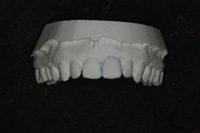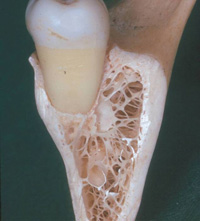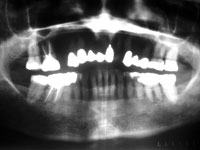 In an ideal practice, patients make their appointments, show up for them, and pay for them. A simple concept, yet one that goes unachieved in many, if not most, practices. How much happier would the entire staff be if, upon reviewing the schedule, they were confident that the patients would indeed show up and payments were not an issue? If you don’t think these issues are part of the practice of dentistry, think again. Once again we have to look at models from other businesses to find the answers.
In an ideal practice, patients make their appointments, show up for them, and pay for them. A simple concept, yet one that goes unachieved in many, if not most, practices. How much happier would the entire staff be if, upon reviewing the schedule, they were confident that the patients would indeed show up and payments were not an issue? If you don’t think these issues are part of the practice of dentistry, think again. Once again we have to look at models from other businesses to find the answers.
WHAT ARE WE REALLY SELLING?
I have asked colleagues this question, and rarely do I get the correct answer. We are not selling bridges, veneers, or even smiles or the ability to chew. The first two are our products, and the latter two are the benefits of the products to our patients, but that is not what we are really selling. We are really selling our time! We use time to produce the products and provide the benefits. The products and the benefits, however, can be achieved at a later date, but the time once lost cannot be recovered.
Let’s look at other industries that sell time, put the procedures that occur in most dental offices into that model, and see how ridiculous it appears. The industry that comes immediately to mind is the vacation rental industry. Just imagine for a moment that you wanted to rent a condominium in Vail or Hawaii. They are selling the same thing we are: irreplaceable time. You’ve called up the resort, and the conversation would go something like this:
“Thank you for calling Holiday Resorts, how can I help you?”
“Hello, I’m interested in reserving a condominium for my family for Christmas week.”
“Well we’re really glad you called us. What are the exact dates of arrival and departure?”
“We’ll be arriving Christmas Eve, the 24th, and departing on January 2nd.”
“What a wonderful vacation. How many are in your party?”
“Five adults.”
“Great, and what type of accommodations would you like?”
“We’d love a three-bedroom condo with a mountain view.”
“Great, we have an available unit in our Mountain Meadows section. Will that work for you?”
“Yes.”
“What name would you like the reservation to be in?”
“I’m Dr. Barotz.”
“Well Dr. Barotz, I’ve got a reservation for you for a three-bedroom condo, in our Mountain Meadow section, mountain view, arriving December 24th and leaving January 2nd. Now, Dr. Barotz, that’s our busiest season, so we really would appreciate it if you showed up when promised. We hope you enjoy your vacation. The total will be $7,000. How would you like to pay for that?”
“Could you just bill me after the vacation? You know, it is the holiday season and we have lots of expenses.”
“Oh, okay, that’ll be fine. We look forward to seeing you.”
Absurd, you say? They would never let you make a reservation without taking a deposit and arranging for payments, usually in advance. Usually you have to pay in full 30 days prior to arrival. If you wish to cancel after that date you are just plain out of luck.
When they ask for the deposit do you feel violated? Of course not! You’ve committed to being there, and you feel secure knowing that your condo will be there waiting for you when you show up. In fact, you have “peace of mind” that one detail of your vacation plans has been squared away.
Now let’s look at industries where they don’t have their act together. For that same vacation you’ll need to rent a car. For this call, the reservation is taken without a deposit. So, what is the likely scenario in this situation? The person making the reservation is likely to call around, check the prices, and make several reservations. Then when he arrives at the airport he checks to see which company has the shortest line, and he uses that reservation. The rental car companies, knowing that many people who make their reservations don’t show up, oversell and in many cases disappoint people who have reservations by not having a car, or at least not the type of car reserved. This leaves their representatives backpedaling, and creates a perception of poor customer service. In short, they never get commitment with a deposit and, in the end, have a poor outcome when it comes to customer service.
Which is the model that epitomizes your practice? The answer is probably neither. Because most fee-for-service dentists are committed to providing quality care, they wouldn’t think of overbooking to ensure their chair is filled. Because the same dentists are also timid about being direct with patients and asking for a commitment, their days are filled with big holes when patients disappoint them by not showing up, and long lists of big numbers with accounts receivable.
The solution to this dilemma is once again a paradigm shift. Recognize that an uncommitted patient is not a patient at all. Recognize that if a patient is serious about receiving the benefits of your services, he or she will have no qualms about placing a deposit to show their commitment. They are used to it in just about every other area of their lives. In our capitalistic society, the way commitments are demonstrated is with some risk of financial loss if the commitment is not kept.
How does this work in the dental practice? It’s really quite simple. For any appointment that involves a significant time commitment, secure a meaningful deposit. This is especially important for comprehensive exam appointments, because it sets the precedent for how you do business. If a patient wants a block of your time for a comprehensive exam, he should be willing to secure that time with a deposit. If this is an issue at all, offer them an opportunity to meet and chat with you without risk, in the form of a no-charge consultation. Wow them with your friendliness when they come in, and then reappoint them (with a deposit or advance payment) for the comprehensive exam after they like what they see.
The verbal skills for this are quite straightforward. Simply state, “We’ll need over an hour for a comprehensive exam. The total fee for this appointment will be $195. In order to reserve this time especially for you, we require a $95 deposit.”
PROPER HANDOFF: THE KEY TO AVOIDING CANCELLATIONS AND RECEIVING PAYMENT FOR TREATMENT APPOINTMENTS
Cancellations and no-shows can be reduced to a bare minimum on treatment appointments as well, by using deposits and effective handoffs from back office personnel to the front office. For example, consider the scenario of a patient requiring a crown for a decayed tooth, at a fee of $1,200. The treatment has been discussed at the chair and supposedly agreed to. Your assistant escorts the patient to the front desk. The following verbal skills should be used when handing the patient off to the appointment secretary.
“It has been a pleasure serving you today, Mrs. Goodpatient. Maria, our appointment secretary, will take care of your receipt for payment for today’s services and your deposit for the next appointment. The doctor is quite concerned about that tooth, so be sure to set up for the crown as soon as possible. You wouldn’t want that to turn into a root canal would you? Thanks for being such a good patient. By the way, if you like the way we treated you, why not refer a friend or family member our way.”
This handoff has four specific elements:
(1) We compliment and thank the patient.
(2) We make it known that payment for today’s services and a deposit for the next appointment are expected and, indeed, required.
(3) The urgency of care is expressed with consequences of delaying treatment.
(4) A referral is asked for.
This is rehearsed over and over at staff meetings, making sure all four elements are included when role-playing.
TODAY STATEMENT: THE FRONT DESK TAKES OVER
Handoff completed, it is now the front desk’s turn to carry the ball. The verbal skills for the front desk personnel are equally as precise, and should continue like this:
“I hope your appointment went well, Mrs. Goodpatient. The balance due for your treatment today is $400, and we require a deposit of $500 to set up your appointment for your crown. Of course, if you would like to pay for your crown in full today, we can extend you a 5% courtesy, which would save you $60. Would you prefer to pay in full today or just place a deposit today? Which would be more convenient for you today?”
We call this our “today statement.” The word today is used five times in relation to payment. The patient has no doubt that we expect finances to be taken care of today! If a patient needs no further treatment, then the today statement is modified to collect payment just for today’s services. It would go as follows:
“The charges for today were $600. Less your deposit of $200 (made at previous appointment) your balance due today is $400. How will you be taking care of that today? Will cash, check, or charge be more convenient for you today?”
What has happened is that you have left no question in the patient’s mind that today is when you expect payment.
The patient will respond several different ways. If you have laid the foundation for payment in full with proper estimates, in most cases they will just pay. The common question that comes up is, what if they protest? That occurs in several different ways. Most often they will respond with what we call insurance statements.
Protest 1: “Well, I have insurance.”
Response: “We’re so glad your insurance company will be reimbursing you. As a courtesy we will fill out all necessary forms for you so that you can receive your check directly from them as soon as possible. Now, how will you be handling the $400 today? Will that be cash, check, or charge today.”
Protest 2: “Can’t my insurance company pay you directly and you bill me for the difference?”
Response: “I’m sorry, but we don’t send out bills, and in order to eliminate undue insurance interference in your treatment, we ask that you pay us directly. Will that be a hardship for you?” If they say no, just collect the money. If they say yes, let them know that you can calculate their estimated co-payment.
At this point we have asked for payment in full for the third time. We have asked if it will be a hardship. Most people will not want to be viewed as a hardship and will comply with our requests. We have only given them the fallback position of paying the estimated co-payment. We have told them “We don’t bill,” so we’ve removed that as an option. At the very least we have collected their co-payment, and they feel like they have won the negotiation. We calculate their co-payment as 40% when the insurance company claims to pay 80%, and two thirds when the insurance company claims to pay 50%. What we don’t end up with is an account receivable.
CONCLUSION
Uncommitted patients are often patients who don’t show up. By securing a deposit for future treatment, no-shows and cancellations can be reduced to a “non-factor” in your office. Combine this with proper verbal skills, and accounts receivable can be eliminated, or at the very least greatly reduced. This policy can be intimidating to implement. It requires rehearsing the necessary verbal skills over and over with frequent role playing. Those offices with the mettle to accept this paradigm shift will benefit from greatly reduced no-shows, accounts receivable, and stress.
Dr. Barotz has a cosmetic/restorative fee-for-service practice in Denver, Colo. He has published in the Journal of the Colorado Dental Association, Crown Council News, and The Profitable Dentist. He has been interviewed for two monthly audiotape series, sponsored by The Profitable Dentist and The Richard Report. He can be contacted at (303) 595-4994 or drbarotz@barotzdental.com.
 In an ideal practice, patients make their appointments, show up for them, and pay for them. A simple concept, yet one that goes unachieved in many, if not most, practices. How much happier would the entire staff be if, upon reviewing the schedule, they were confident that the patients would indeed show up and payments were not an issue? If you don’t think these issues are part of the practice of dentistry, think again. Once again we have to look at models from other businesses to find the answers.
In an ideal practice, patients make their appointments, show up for them, and pay for them. A simple concept, yet one that goes unachieved in many, if not most, practices. How much happier would the entire staff be if, upon reviewing the schedule, they were confident that the patients would indeed show up and payments were not an issue? If you don’t think these issues are part of the practice of dentistry, think again. Once again we have to look at models from other businesses to find the answers.










